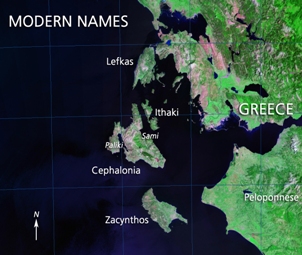
If the peninsula of Paliki was a free-standing island 3200 years ago, it would exactly match Homer's description of Odysseus's Ithaca, solving a classical enigma that has puzzled scholars for thousands of years and explaining why no convincing archaeological evidence of Odysseus's palace has ever been found on modern Ithaki. It also would concur with the description of the area by the ancient geographer Strabo, who wrote "where the island is narrowest it forms an isthmus so low-lying that it is often submerged from sea to sea".
Further support also comes from a marine seismic and bathymetric survey of the enclosed gulf to the south of where "Strabo's Channel" is inferred to have lain. Conducted jointly by Professor Underhill and a team from the Athens-based national geological institute (IGME) led by Dr Constantine Perissoratis, these surveys have confirmed the existence of a distinctive offshore marine valley about 28m deep that lines up perfectly with that point on the coast where Strabo's Channel is inferred to have had its southern exit.
Prof. Underhill now thinks he understands how this valley may have formed, and how the channel became obliterated over the last 3000 years. "At the time of the last main interglacial, about 125,000 years ago, sea-levels were at a similar or slightly higher level than today. From there, sea-level dropped worldwide by about 120m over the next 100,000 years or so to reach their lowest point around 21,500 years ago during the last glacial maximum."
Although ice never reached Greece, sea-levels began to recover as the ice-caps melted in higher latitudes. "Marine waters reached the upper part of the gulf as recently as 5000-6000ka years ago" says Underhill, “after the enhanced upstream erosion that took place due to the lowering of local base levels. It is this rise that may have enabled the sea to connect right through the Thinia Valley."